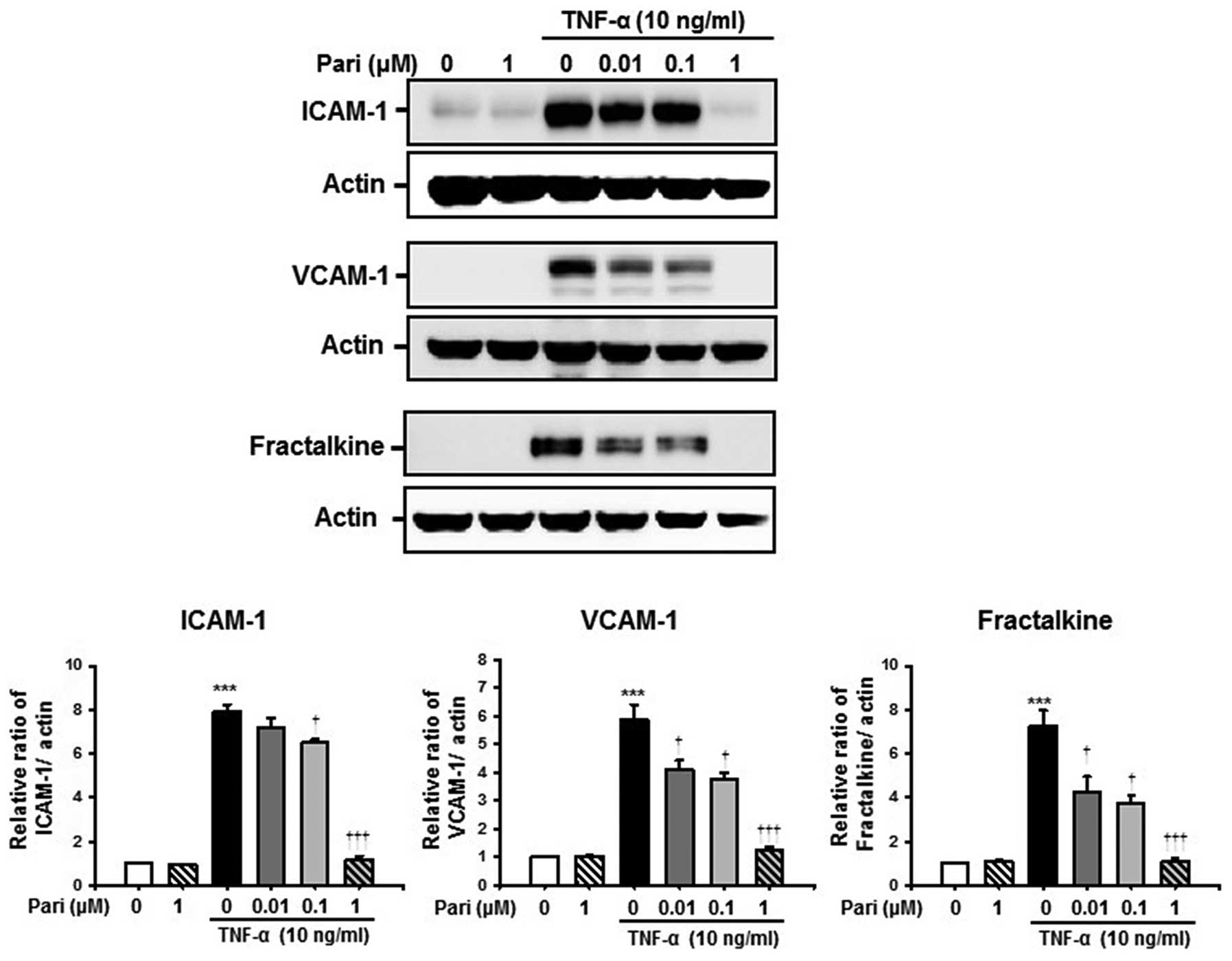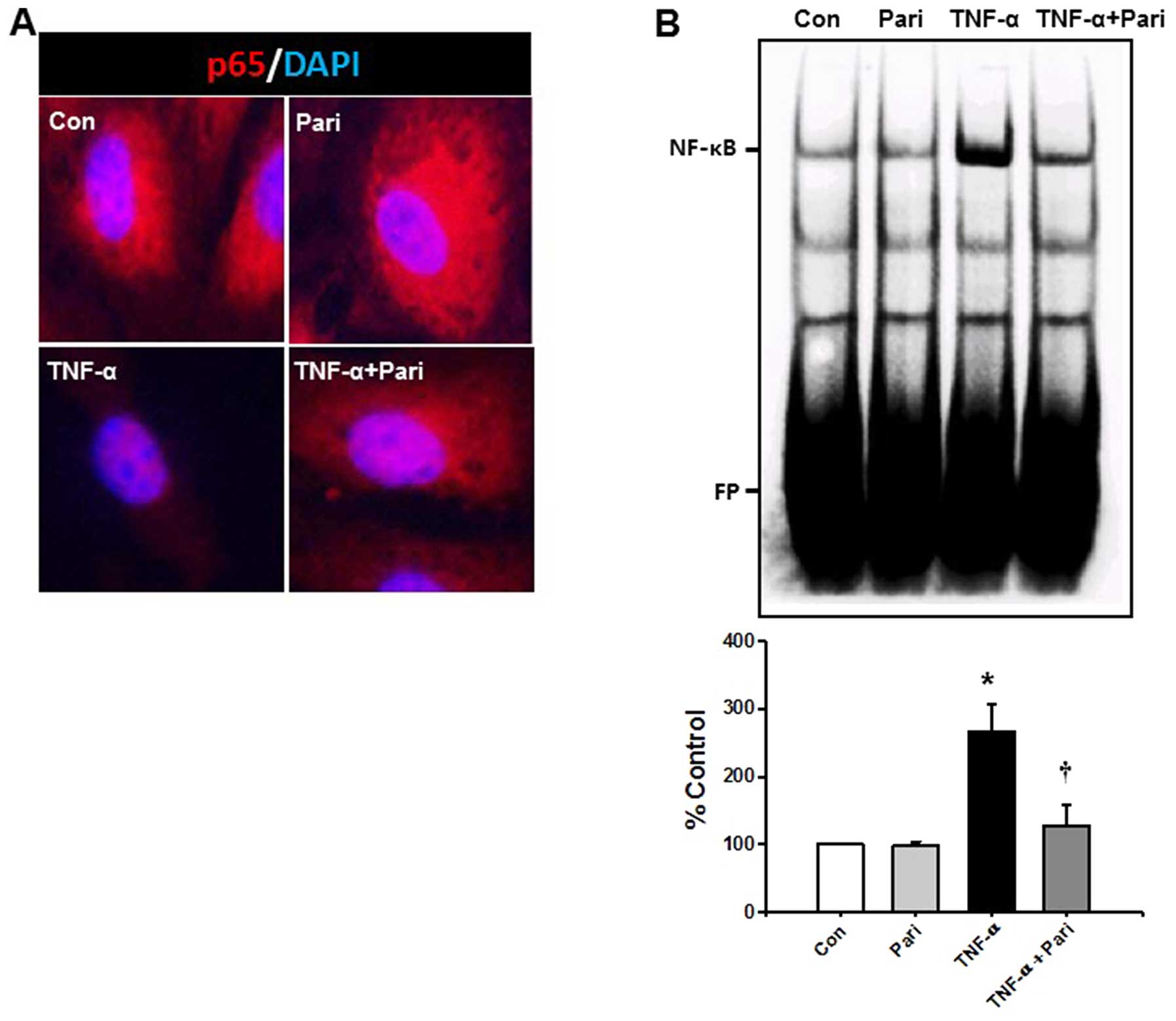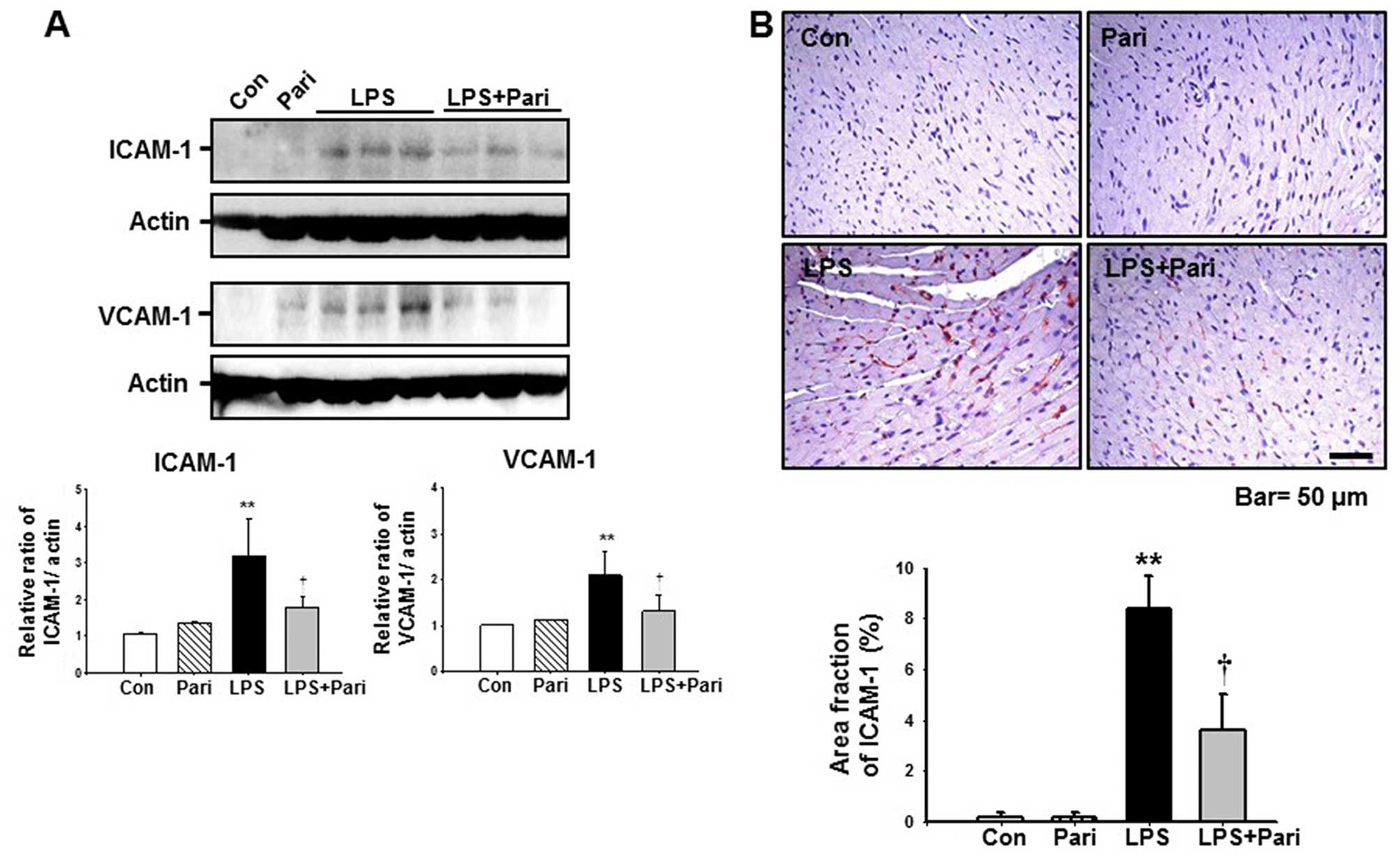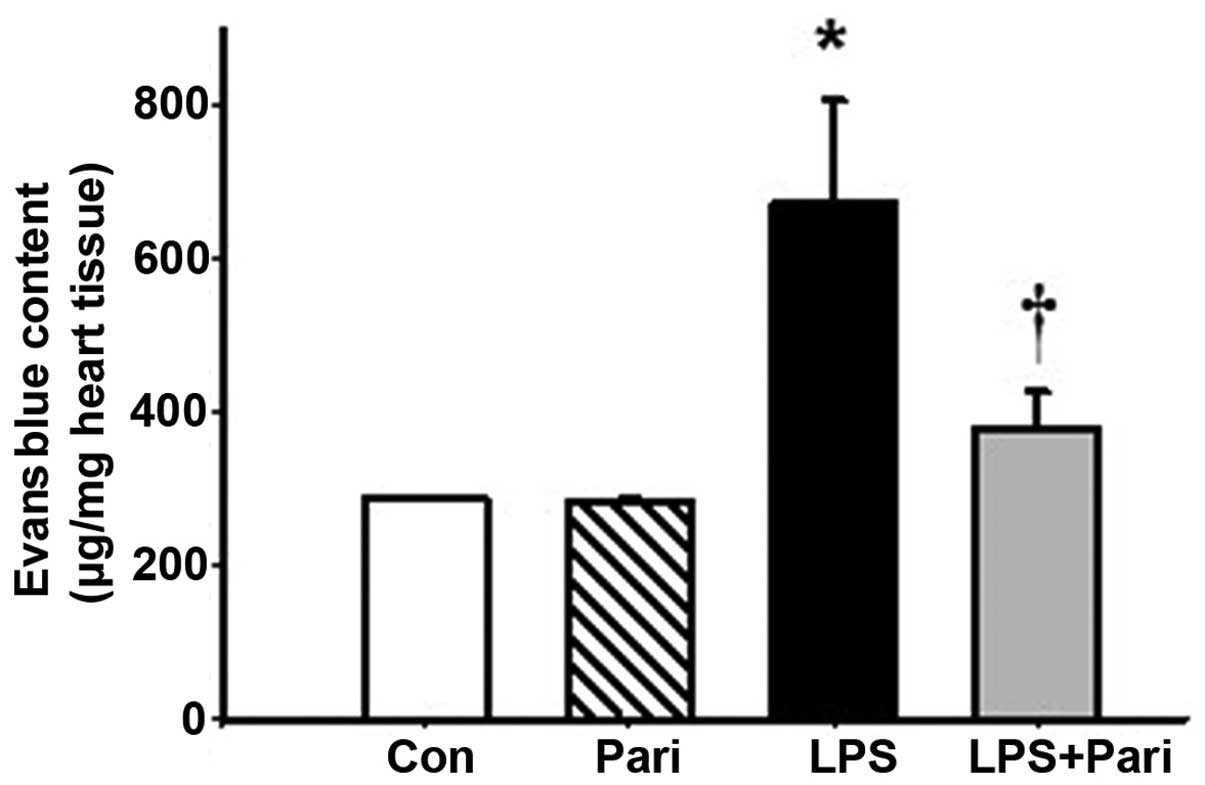Paricalcitol attenuates lipopolysaccharide-induced myocardial inflammation by regulating the NF-κB signaling pathway
- Authors:
- Published online on: March 4, 2016 https://doi.org/10.3892/ijmm.2016.2516
- Pages: 1023-1029
-
Copyright: © Lee et al. This is an open access article distributed under the terms of Creative Commons Attribution License.
Abstract
Introduction
Vitamin D and its active metabolites play a major role in bone mineral metabolism. The prevalence of vitamin D deficiency is high worldwide, with latitude and socioeconomic status as major determinants (1). Subclinical vitamin D deficiency is associated with the development of osteoporosis and an increased risk of falls and fractures in older patients (2,3). In addition, vitamin D deficiency is associated with an increased risk of cardiovascular disease, diabetes, colon and breast cancer, infectious diseases and allergies (4). Meta-analyses of data have demonstrated that vitamin D supplementation may have beneficial effects on bone health in older individuals and on mortality in adults; however, evidence for the effectiveness of vitamin D supplementation in cancer prevention is contradictory (5,6). In animal studies, vitamin D therapy has been shown to prevent progressive cardiac hypertrophy and the development of heart failure (7,8). However, results regarding the benefits of vitamin D supplementation in cardiovascular disease in humans remain controversial (9). Therefore, further investigation is warranted into the effects of vitamin D on the cardiovascular system.
Vascular alterations in sepsis are an important pathophysiological mechanism that is characterized by the dysregulation of vasoreactive mediators, increased vascular permeability, leukocyte recruitment, unregulated expression of cell adhesion molecules and abnormal hemostasis (10). Sepsis also induces myocardial depression through microcirculatory alterations, autonomic dysregulation, metabolic and mitochondrial dysfunction, cell death, and myocardial inflammation (11). These vascular alterations in combination with myocardial dysfunction lead to high mortality and morbidity in patients with sepsis (11).
Pharmacological intervention for the prevention and treatment of sepsis is challenging due to limitations to the development of novel drugs, and a need for multidisciplinary approaches to managing patients with sepsis. Targeting vascular alterations would provide novel therapeutic strategies for the treatment of sepsis. Previously, we reported that the blockade of Janus kinase 3 (JAK3) by JANEX-1 (a JAK3 inhibitor) attenuated the tumor necrosis factor (TNF)-α-induced increase in cell adhesion molecule expression in endothelial cells, and improved myocardial vascular permeability in endotoxemic mice (12).
Paricalcitol, 19-nor-1-α-25-dihydroxyvitamin D2, is a vitamin D2 analogue that activates the vitamin D receptor (VDR), resulting in the reduced intestinal absorption of calcium and phosphorus, and calcium mobilization from bone (13). Paricalcitol is well tolerated in patients with secondary hyperparathyroidism and it is available in two formulations, intravenous and oral (14–16). Studies have suggested that paricalcitol exerts beneficial effects on renal inflammation through the modulation of the nuclear factor (NF)-κB pathway in a model of cyclosporine-induced kidney injury and a model of renal fibrosis (17,18). However, the protective effects of paricalcitol on endotoxemia-induced myocardial inflammation remain unknown. Thus, in the present study, we aimed to investigate the effects of paricalcitol on lipopolysaccharide (LPS)-induced myocardial inflammation, and to elucidate the mechanisms responsible for these effects.
Materials and methods
Cell culture and immunocytochemistry
Human umbilical vein endothelial cells (HUVECs) were obtained from Lonza Walkersville, Inc. (Walkersville, MD, USA) and cultured in endothelial basal medium (EBM)-2 complete medium supplemented with 2% (v/v) heat-inactivated fetal bovine serum at 37°C in 5% CO2. To examine the effects of paricalcitol on the LPS-induced increase in cell adhesion molecule expression in HUVECs, subconfluent endothelial cells were incubated with paricalcitol (Tocris Bioscience, Minneapolis, MN, USA; 0.01, 0.1 or 1 µM) for 30 min and then stimulated with 10 ng/ml TNF-α (R&D Systems, Minneapolis, MN, USA) for 6 h.
For p65 immunocytochemistry, the HUVECs were cultured in 6-well plates and treated with 1 µM paricalcitol for 30 min and then stimulated with 10 ng/ml TNF-α for 6 h. Following 4% paraformaldehyde fixation, the cells were washed with phosphate-buffered saline (PBS), permeabilized in 0.25% Triton X-100 and blocked with 1% goat serum. The HUVECs were then incubated with primary anti-p65 antibody (#4764; Cell Signaling Technology, Beverly, MA, USA), followed by staining with Cy3-conjugated secondary antibody (AP182C; Chemicon, Temecula, CA, USA). For nuclear staining, the HUVECs were incubated with 4′,6-diamidino-2-phenylinole (DAPI; Molecular Probes, Eugene, OR, USA).
Western blot analysis
Western blot analysis was performed as described previously (12). Primary antibodies against intercellular adhesion molecule-1 (ICAM-1; sc-1511), vascular cell adhesion molecule-1 (VCAM-1; sc-1504) (both from Santa Cruz Biotechnology, Santa Cruz, CA, USA), fractalkine (TP-213; Torrey Pines BioLabs, Houston, TX, USA), phosphorylated (p)-p65 (#3033) and p65 (#4764; both from Cell Signaling Technology) were used. The membranes were reblotted with anti-actin antibody to verify the equal loading of protein in each lane. All signals were visualized using chemiluminescent reagents (Amersham Pharmacia Biotech, London, UK) and analyzed using a densitometric scanner (LAS-3000; FujiFilm, Tokyo, Japan).
Electrophoretic mobility shift assays (EMSAs)
EMSAs for NF-κB p65 were performed as described previously (12). The HUVECs were incubated with control buffer or 1 µM paricalcitol for 30 min and then stimulated with 10 ng/ml TNF-α for 4 h and nuclear extracts were prepared. PBS was used as a control buffer. Signals were detected using chemiluminescent EMSA imaging kits according to the manufacturer's instructions (Panomics, Inc., Fremont, CA, USA).
Animal experiments
The animal experimental protocol was reviewed and approved by the Institutional Animal Care and Use Committee of Chonbuk National University, Jeonju, Korea (CBU 2014-00060). Male C57BL/6 mice (7 weeks old, weighing 20–23 g) were obtained from Orient Bio Inc. (Seoul, Korea) and maintained in an environmentally controlled room (temperatue, 23±1°C; humidity, 50±10%), with lighting on a 12-h light/12-h dark cycle and free access to water and standard chow. The mice were divided into the following 4 groups: i) control buffer-treated (n=10); ii) paricalcitol-treated (n=10); iii) LPS administration (n=10); and iv) LPS administration plus paricalcitol treatment (n=10). PBS was used as the control buffer. Pre-treatment with 0.2 µg/kg paricalcitol was administered by daily intraperitoneal injections for 5 days. Endotoxemia was induced by an intraperitoneal injection of 15 mg/kg LPS (Sigma-Aldrich, St. Louis, MO, USA). The doses of LPS and paricalcitol were selected based on previous studies (12,17). At 16 h after the induction of endotoxemia, the mice were anesthetized with 100 mg/kg ketamine (Huons, Seoul, Korea) and 10 mg/kg xylazine (Bayer Korea, Seoul, Korea). The hearts were harvested for western blot analysis and histological examination.
Immunohistochemical analysis of myocardial ICAM-1 expression
Immunohistochemical staining for ICAM-1 was performed as previously described (19). The isolated heart tissues were fixed by immersion in 4% paraformaldehyde and embedded in paraffin. The tissue sections were deparaffinized with xylene and rehydrated in graded ethanol baths. Following treatment with blocking buffer, the slides were incubated overnight at 4°C with either hamster anti-mouse ICAM-1 or hamster IgG (both from BD Biosciences-Pharmingen, San Jose, CA, USA) as a control. The heart sections were exposed to Dako Chromogen (DakoCytomation, Glostrup, Denmark) to visualize immunocomplexes, and counterstained with hematoxylin (Sigma-Aldrich). For morphometric analysis, the slides were evaluated using a Zeiss Z1 microscope (Carl Zeiss, Göttingen, Germany) by two observers who were unaware of the slide origins. The extent of ICAM-1 immunostaining in the heart tissue was expressed as a percentage of the area of 10 random, non-overlapping fields per slide at x400 magnification using ImageJ software (http://rsb.info.nih.gov/ij).
Measurement of myocardial tumor necrosis factor-α levels
The TNF-α levels were determined using enzyme-linked immunosorbent assay (ELISA) kits (R&D Systems) according to the manufacturer's instructions. Briefly, 50 µl of assay diluent, standard dilutions and protein samples were added to each well and mixed by gently tapping the plate. The plate was covered and incubated for 2 h at room temperature. After washing each well with washing buffer, mouse TNF-α conjugate was added to each well and incubated for 2 h at room temperature. After washing, substrate solutions were added to each well followed by incubation for 30 min and stop solutions were then added. The optical density of each well was determined using a microplate reader set at 450 nm.
Measurement of vascular permeability using Evans blue dye
To measure myocardial permeability, Evans blue dye assays were performed as previously described (12). Evans blue dye (50 mg/kg; Sigma-Aldrich) dissolved in 200 µl PBS was injected into the tail veins of the mice following the induction of endotoxemia induction. At 16 h after the induction of endotoxemia, the mice were sacrificed by CO2 asphyxiation. At sacrifice, the mice were perfused with PBS through the left ventricle until all blood was eliminated. The hearts were excised, weighed and homogenized in 1 ml formamide. The samples were incubated at 55°C for 18 h and centrifuged at 16,000 × g for 30 min at 4°C. The amount of Evans blue dye in the supernatant was determined by measuring the absorbance at 620 nm using a SmartSpec Plus spectrophotometer (Bio-Rad, Hercules, CA, USA).
Statistical analysis
Data are expressed as the means ± SD. Mean comparisons between 2 groups were examined for significant differences using ANOVA, followed by individual comparisons with a Tukey's post hoc test, with a P-value <0.05 considered to indicate a statistically significant difference.
Results
Paricalcitol suppresses the TNF-α-induced increase in the expression of cell adhesion molecules in HUVECs
To examine the effects of paricalcitol on the TNF-α-induced increase in the expression of ICAM-1, VCAM-1 and fractalkine, the HUVECs were treated with paricalcitol for 30 min and then stimulated with TNF-α for 6 h. Western blot analysis revealed that TNF-α significantly increased the protein levels of ICAM-1, VCAM-1 and fractalkine compared with the controls. Treatment with paricalcitol suppressed the TNF-α-induced increase in the expression of ICAM-1, VCAM-1 and fractalkine in a dose-dependent manner. Treatment with paricalcitol alone did not alter the expression of the cell adhesion molecules (Fig. 1).
Paricalcitol suppresses the TNF-α-induced activation of NF-κB in HUVECs
The NF-κB signaling pathway is a major signaling pathway involved in the TNF-α-induced expression of cell adhesion molecules. Therefore, we examined the effects of paricalcitol on the TNF-α-induced activation of the NF-κB signaling pathway using immunocytochemistry and EMSA. p65 protein was abundant in the cytoplasm of the control- and paricalcitol-treated cells. However, TNF-α decreased the cytoplasmic expression of p65 in the HUVECs. Pre-treatment with paricalcitol prevented the TNF-α-induced depletion of cytoplasmic p65 in the HUVECs (Fig. 2A).
To examine the effects of paricalcitol on the NF-κB DNA binding activity induced by TNF-α, nuclear extracts from the TNF-α-stimulated HUVECs were examined using EMSA. TNF-α significantly increased the NF-κB DNA binding activity in the nuclear extracts by 2.6-fold compared with that observed in the HUVECs treated with control buffer. The increase in the TNF-α-induced DNA binding activity of NF-κB in the HUVECs was significantly decreased by 51.8% following treatment with paricalcitol (Fig. 2B). We did not observe any increase in the DNA binding activity of NF-κB in the cells treated only with control buffer or paricalcitol. These data suggested that paricalcitol prevented the TNF-α-induced increase in the DNA binding activity of NF-κB in the HUVECs.
Paricalcitol attenuates LPS-induced myocardial inflammation in mice
We wished to determine whether paricalcitol suppresses LPS-induced myocardial inflammation. At 16 h after the LPS injection, myocardial ICAM-1 expression had increased by 3.2-fold and VCAM-1 expression had increased by 2.1-fold compared with the controls. Pre-treatment with paricalcitol suppressed the LPS-induced increase in myocardial ICAM-1 and VCAM-1 expression by approximately 43.8 and 37.1%, respectively, compared with the LPS-treated group (Fig. 3A). Treatment with paricalcitol alone did not induce ICAM-1 and VCAM-1 expression in the mouse hearts. To evaluate the localization of LPS-induced ICAM-1 expression in the myocardium, we examined the heart sections using ICAM-1 immunohistochemistry. After the injection of LPS, myocardial ICAM-1 expression increased in the arteriolar and capillary endothelial cells compared with the control samples. Pre-treatment with paricalcitol suppressed the increase in myocardial ICAM-1 expression (Fig. 3B).
To further examine the anti-inflammatory effects of paricalcitol, we measured the myocardial TNF-α levels using ELISA. The myocardial TNF-α levels increased significantly following the induction of endotoxemia by LPS (7.29±1.02 pg/mg protein) compared with that in the controls (4.66±0.11 pg/mg protein) or in the samples from the mice treated with paricalcitol (4.74±0.59 pg/mg protein) (Fig. 3C). Treatment with paricalcitol reduced the LPS-induced increase in TNF-α levels (5.42±0.11 pg/mg protein). These data suggested that paricalcitol attenuated LPS-induced myocardial inflammation.
Our in vitro data suggested that paricalcitol exerted anti-inflammatory effects through the modulation of the NF-κB signaling pathway. Therefore, we wished to determine whether paricalcitol can prevent the LPS-induced myocardial activation of p65 in vivo. The level of p-p65 in the myocardium after the injection of LPS increased 1.66-fold compared with that in the control samples. Treatment with paricalcitol suppressed the LPS-induced increase in p-p65 levels (Fig. 3D). These data suggested that paricalcitol inhibited the LPS-induced activation of the myocardial NF-κB signaling pathway.
Paricalcitol alleviates myocardial vascular leakage in mice with LPS-induced endotoxemia
Endotoxemia is characterized by an increase in vascular leakage (12); thus, in this study, we examined the effects of paricalcitol on LPS-induced myocardial permeability using Evans blue dye, as previoulsy described (12). At 16 h after the LPS injection, myocardial vascular leakage was significantly increased. Treatment with paricalcitol significantly suppressed the LPS-induced increase in vascular leakage (Fig. 4). These data suggested that paricalcitol exerted protective effects against LPS-induced myocardial vascular leakage.
Discussion
The present study demonstrated that paricalcitol suppressed the TNF-α-induced expression of cell adhesion molecules in endothelial cells by modulating the NF-κB signaling pathway. Paricalcitol also attenuated endotoxemia-induced myocardial inflammation and vascular leakage.
Vascular endothelial cells constitute a continuous and semipermeable barrier in the vascular bed (20). During septic shock, this endothelial barrier function is impaired. The breakdown of the endothelial barrier is initiated by the activation of the coagulation system and impaired fibrinolysis, which leads to tissue hypoperfusion. Leukocyte adhesion to endothelial cells is mediated by soluble cytokines or cell adhesion molecules. Finally, endothelial cell-cell junctions, such as vascular endothelial cadherin and zona occludens are broken, resulting in the leakage of proteins and solutes that induces interstitial edema (21). Therefore, preserving endothelial barrier function is an important approach in the treatment of patients with sepsis.
The NF-κB signaling pathway is central to TNF-α-induced endothelial cell activation. Tan et al reported that paricalcitol decreased TNF-α-induced tubular RANTES induction through VDR-mediated NF-κB sequestration (18). In our in vitro experiments, we demonstrated that paricalcitol effectively suppressed the TNF-α-induced increase in ICAM-1, VCAM-1 and fractalkine expression in endothelial cells. For the activation of the NF-κB signaling pathway, nuclear translocation of the NF-κB p65 subunit is important (22). Our immunocyto-chemical data revealed that paricalcitol effectively decreased the TNF-α-induced NF-κB p65 nuclear translocation. Our EMSA data demonstrated that paricalcitol decreased the TNF-α-induced DNA binding activity of NF-κB in endothelial cells. These data suggest that paricalcitol may exert protective effects against TNF-α-induced endothelial cell activation and inflammation by regulating NF-κB nuclear translocation and DNA binding.
Impaired vascular permeability is important in the pathophysiology of sepsis (12). Increased vascular permeability is characterized by the extravasation of interstitial fluid and the failure of vascular responses (23). In our animal model, myocardial permeability was increased following LPS-induced endotoxemia. Pre-treatment with paricalcitol significantly decreased the increase in vascular permeability induced by endotoxemia. In addition, paricalcitol effectively decreased the LPS-induced increase in myocardial ICAM-1 and VCAM-1 expression. These data suggested that paricalcitol affected both cell adhesion molecule expression and vascular permeability in mice with endotoxemia.
VDR is ubiquitously distributed in human tissue and exerts pleiotropic effects on the regulation of oxidative stress, immune modulation and inflammation (24,25). The co-stimulation of human macrophages by Toll-like receptor ligands and 25(OH) vitamin D has been shown to upregulate the VDR and 1α-hydroxylase genes, which enhances the antimicrobial effects of cathelicidin (26,27). In ischemic kidney injury, pre-treatment with paricalcitol has been shown to decrease renal inflammation by suppressing the TLR4-NF-κB signaling pathway (28). Therefore, vitamin D may be important in the innate immune system. Jeng et al found that patients in the intensive care unit with sepsis had lower 25(OH) vitamin D levels than the healthy controls (29). This study demonstrated that paricalcitol decreased the LPS-induced increase in myocardial TNF-α levels, and suppressed the activation of myocardial NF-κB in mice with endotoxemia.
In conclusion, the findings of our study demonstrated that paricalcitol suppressed the TNF-α-induced increase in the expression of cell adhesion molecules in endothelial cells and thus it may exert protective effects against endotoxemia-induced vascular inflammation by modulating the NF-κB signaling pathway.
Acknowledgments
The authors would like to thank Kieu Thi Thu Trang for providing excellent technical assistance. This study was supported by the National Research Foundation of Korea, funded by the Korean government (2008-0062279, to W.K. and NRF-2014R1A1A4A01003832, to S.K.P.) and by the Fund of Biomedical Research Institute, Chonbuk National University Hospital in 2012 (to S.K.P.).
References
|
Lips P: Worldwide status of vitamin D nutrition. J Steroid Biochem Mol Biol. 121:297–300. 2010. View Article : Google Scholar : PubMed/NCBI | |
|
Faulkner KA1, Cauley JA, Zmuda JM, Landsittel DP, Newman AB, Studenski SA, Redfern MS, Ensrud KE, Fink HA, Lane NE and Nevitt MC: Higher 1,25-dihydroxyvitamin D3 concentrations associated with lower fall rates in older community-dwelling women. Osteoporos Int. 17:1318–1328. 2006. View Article : Google Scholar : PubMed/NCBI | |
|
Bischoff-Ferrari HA, Dietrich T, Orav EJ and Dawson-Hughes B: Positive association between 25-hydroxy vitamin D levels and bone mineral density: a population-based study of younger and older adults. Am J Med. 116:634–639. 2004. View Article : Google Scholar : PubMed/NCBI | |
|
Thacher TD and Clarke BL: Vitamin D insufficiency. Mayo Clinic proceedings. Mayo Clin. 86:50–60. 2011. View Article : Google Scholar | |
|
Bjelakovic G, Gluud LL, Nikolova D, Whitfield K, Krstic G, Wetterslev J and Gluud C: Vitamin D supplementation for prevention of cancer in adults. Cochrane Database Syst Rev. 6:CD0074692014.PubMed/NCBI | |
|
Bjelakovic G, Gluud LL, Nikolova D, Whitfield K, Wetterslev J, Simonetti RG, Bjelakovic M and Gluud C: Vitamin D supplementation for prevention of mortality in adults. Cochrane Database Syst Rev. 1:CD0074702014.PubMed/NCBI | |
|
Bae S, Yalamarti B, Ke Q, Choudhury S, Yu H, Karumanchi SA, Kroeger P, Thadhani R and Kang PM: Preventing progression of cardiac hypertrophy and development of heart failure by paricalcitol therapy in rats. Cardiovasc Res. 91:632–639. 2011. View Article : Google Scholar : PubMed/NCBI | |
|
Bodyak N, Ayus JC, Achinger S, Shivalingappa V, Ke Q, Chen YS, Rigor DL, Stillman I, Tamez H, Kroeger PE, et al: Activated vitamin D attenuates left ventricular abnormalities induced by dietary sodium in Dahl salt-sensitive animals. Proc Natl Acad Sci USA. 104:16810–16815. 2007. View Article : Google Scholar : PubMed/NCBI | |
|
Zittermann A: Vitamin D and cardiovascular disease. Anticancer Res. 34:4641–4648. 2014.PubMed/NCBI | |
|
Dauphinee SM and Karsan A: Lipopolysaccharide signaling in endothelial cells. Lab Invest. 86:9–22. 2006. View Article : Google Scholar | |
|
Rudiger A and Singer M: Mechanisms of sepsis-induced cardiac dysfunction. Crit Care Med. 35:1599–1608. 2007. View Article : Google Scholar : PubMed/NCBI | |
|
Lee JE, Lee AS, Kim DH, Jung YJ, Lee S, Park BH, Lee SH, Park SK, Kim W and Kang KP: Janex-1, a JAK3 inhibitor, ameliorates tumor necrosis factor-α-induced expression of cell adhesion molecules and improves myocardial vascular permeability in endotoxemic mice. Int J Mol Med. 29:864–870. 2012.PubMed/NCBI | |
|
Dyer CA: Safety and tolerability of paricalcitol in patients with chronic kidney disease. Expert Opin Drug Saf. 12:717–728. 2013. View Article : Google Scholar : PubMed/NCBI | |
|
Lindberg J, Martin KJ, González EA, Acchiardo SR, Valdin JR and Soltanek C: A long-term, multicenter study of the efficacy and safety of paricalcitol in end-stage renal disease. Clin Nephrol. 56:315–323. 2001.PubMed/NCBI | |
|
Llach F, Keshav G, Goldblat MV, Lindberg JS, Sadler R, Delmez J, Arruda J, Lau A and Slatopolsky E: Suppression of parathyroid hormone secretion in hemodialysis patients by a novel vitamin D analogue: 19-nor-1,25-dihydroxyvitamin D2. Am J Kidney Dis. 32(Suppl 2): S48–S54. 1998. View Article : Google Scholar : PubMed/NCBI | |
|
Coyne D, Acharya M, Qiu P, Abboud H, Batlle D, Rosansky S, Fadem S, Levine B, Williams L, Andress DL and Sprague SM: Paricalcitol capsule for the treatment of secondary hyperparathyroidism in stages 3 and 4 CKD. Am J Kidney Dis. 47:263–276. 2006. View Article : Google Scholar : PubMed/NCBI | |
|
Park JW, Bae EH, Kim IJ, Ma SK, Choi C, Lee J and Kim SW: Paricalcitol attenuates cyclosporine-induced kidney injury in rats. Kidney Int. 77:1076–1085. 2010. View Article : Google Scholar : PubMed/NCBI | |
|
Tan X, Wen X and Liu Y: Paricalcitol inhibits renal inflammation by promoting vitamin D receptor-mediated sequestration of NF-kappaB signaling. J Am Soc Nephrol. 19:1741–1752. 2008. View Article : Google Scholar : PubMed/NCBI | |
|
Kang KP, Kim DH, Jung YJ, Lee AS, Lee S, Lee SY, Jang KY, Sung MJ, Park SK and Kim W: Alpha-lipoic acid attenuates cisplatin-induced acute kidney injury in mice by suppressing renal inflammation. Nephrol Dial Transplant. 24:3012–3020. 2009. View Article : Google Scholar : PubMed/NCBI | |
|
Matsuda N and Hattori Y: Vascular biology in sepsis: pathophysiological and therapeutic significance of vascular dysfunction. J Smooth Muscle Res. 43:117–137. 2007. View Article : Google Scholar : PubMed/NCBI | |
|
Opal SM and van der Poll T: Endothelial barrier dysfunction in septic shock. J Intern Med. 277:277–293. 2015. View Article : Google Scholar | |
|
Sung MJ, Kim W, Ahn SY, Cho CH, Koh GY, Moon SO, Kim DH, Lee S, Kang KP, Jang KY and Park SK: Protective effect of alpha-lipoic acid in lipopolysaccharide-induced endothelial fractalkine expression. Circ Res. 97:880–890. 2005. View Article : Google Scholar : PubMed/NCBI | |
|
Aird WC: The role of the endothelium in severe sepsis and multiple organ dysfunction syndrome. Blood. 101:3765–3777. 2003. View Article : Google Scholar : PubMed/NCBI | |
|
Donate-Correa J, Domínguez-Pimentel V, Méndez-Pérez ML, Muros-de-Fuentes M, Mora-Fernández C, Martín-Núñez E, Cazaña-Pérez V and Navarro-González JF: Selective vitamin D receptor activation as anti-inflammatory target in chronic kidney disease. Mediators Inflamm. 2014(670475)2014. View Article : Google Scholar : PubMed/NCBI | |
|
Andress D: Nonclassical aspects of differential vitamin D receptor activation: implications for survival in patients with chronic kidney disease. Drugs. 67:1999–2012. 2007. View Article : Google Scholar : PubMed/NCBI | |
|
Watkins RR, Yamshchikov AV, Lemonovich TL and Salata RA: The role of vitamin D deficiency in sepsis and potential therapeutic implications. J Infect. 63:321–326. 2011. View Article : Google Scholar : PubMed/NCBI | |
|
Liu PT, Stenger S, Li H, Wenzel L, Tan BH, Krutzik SR, Ochoa MT, Schauber J, Wu K, Meinken C, et al: Toll-like receptor triggering of a vitamin D-mediated human antimicrobial response. Science. 311:1770–1773. 2006. View Article : Google Scholar : PubMed/NCBI | |
|
Lee JW, Kim SC, Ko YS, Lee HY, Cho E, Kim MG, Jo SK, Cho WY and Kim HK: Renoprotective effect of paricalcitol via a modulation of the TLR4-NF-κB pathway in ischemia/reperfusion-induced acute kidney injury. Biochem Biophys Res Commun. 444:121–127. 2014. View Article : Google Scholar : PubMed/NCBI | |
|
Jeng L, Yamshchikov AV, Judd SE, Blumberg HM, Martin GS, Ziegler TR and Tangpricha V: Alterations in vitamin D status and anti-microbial peptide levels in patients in the intensive care unit with sepsis. J Transl Med. 7(28)2009. View Article : Google Scholar : PubMed/NCBI |













